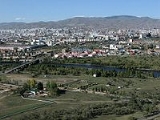
Ulaanbaatar
Overview
Mongolia
Mongolia is a landlocked country in East and Central Asia. It is bordered by Russia to the north and China to the south, east and west. Although Mongolia does not share a border with Kazakhstan, its western-most point is only from Kazakhstan's eastern tip. Ulan Bator, the capital and largest...
. An independent municipality, the city is not part of any province
Aimags of Mongolia
Mongolia is divided into 21 aimags . Each aimag is subdivided into several sums. The name aimag is derived from the Mongolian and Turkic languages word for "tribe". The modern aimags were established since 1921...
, and its population as of 2008 is over one million.
Located in north central Mongolia, the city lies at an elevation of about 1310 metres (4,297.9 ft) in a valley on the Tuul River
Tuul River
Tuul River is a river in central and northern Mongolia considered sacred by the Mongols. It is 704 km long and drains an area 49,840 square km. The river is called the "Duluo river" in the Suishu, a Chinese historical work completed in 636 AD...
. It is the cultural, industrial, and financial heart of the country. It is the center of Mongolia's road network, and is connected by rail to both the Trans-Siberian Railway
Trans-Siberian Railway
The Trans-Siberian Railway is a network of railways connecting Moscow with the Russian Far East and the Sea of Japan. It is the longest railway in the world...
in Russia and the Chinese
China
Chinese civilization may refer to:* China for more general discussion of the country.* Chinese culture* Greater China, the transnational community of ethnic Chinese.* History of China* Sinosphere, the area historically affected by Chinese culture...
railway system.
The city was founded in 1639 as a movable (nomadic) Buddhist
Buddhism in Mongolia
Buddhism in Mongolia derives much of its recent characteristics from Tibetan Buddhism of the Gelugpa school. Traditionally, Mongols worshiped heaven and their ancestors, and they followed ancient northern Asian practices of shamanism, in which human intermediaries went into trance and spoke to...
monastic
Buddhist monasticism
Monasticism is one of the most fundamental institutions of Buddhism. Monks and nuns are responsible for preserving and teaching Buddhist teachings and guiding Buddhist lay followers. Earlier Buddhist monks were enlightened...
centre.
Unanswered Questions

